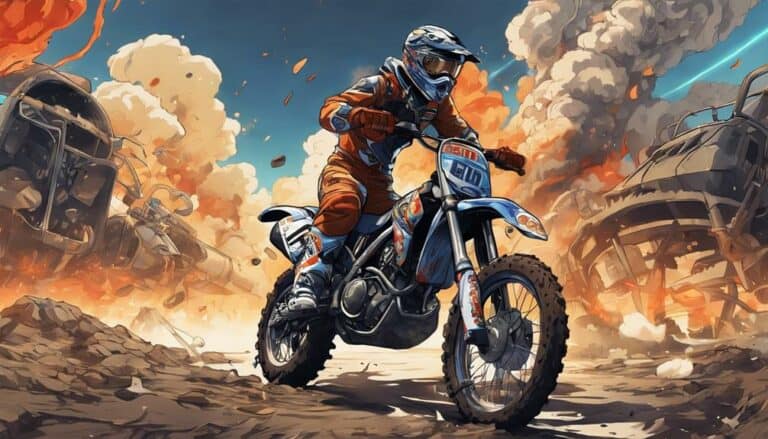If you've ever wondered why vapor lock occurs in dirt bikes, you might have assumed it's a rare occurrence. However, understanding the causes behind this issue can shed light on how vital factors to ponder.
From the impact of heat on fuel to the role of modern fuel blends in exacerbating vapor lock, there are essential elements to ponder.
Stay tuned to uncover the secrets of vapor lock in dirt bikes and equip yourself with the knowledge to tackle this challenge head-on.
Key Takeaways
- High temperatures and carburetor design contribute to vapor lock in dirt bikes.
- Electric fuel pump issues and modern fuel blends worsen vapor lock.
- Symptoms include engine restart difficulties and fuel delivery disruptions.
- Prevent vapor lock by insulating fuel lines and using ethanol-free fuel.
Understanding Vapor Lock in Dirt Bikes
Vapor lock in dirt bikes occurs when fuel boils in the carburetor or fuel line, creating back pressure that obstructs fuel delivery to the engine. This phenomenon is particularly problematic in modern dirt bikes due to the lower boiling points of contemporary fuel blends. Idling or restarting the engine can worsen vapor lock issues, leading to difficulties in fuel delivery, especially in fuel-injected engines with electric fuel pumps. The design and operation of these systems make them more prone to vapor lock compared to traditional carbureted setups.
Recognizing the symptoms of vapor lock, such as engine restart challenges, is essential for addressing potential fuel delivery disruptions promptly. To combat vapor lock in dirt bikes effectively, consider installing an electric fuel pump or a plastic carb spacer. These solutions help mitigate the effects of fuel boiling and back pressure, ensuring smoother engine performance and reducing the likelihood of vapor lock occurrences.
Common Causes of Vapor Lock
One common trigger for vapor lock in dirt bikes stems from the interaction between fuel properties and engine heat during operation. When fuel boiling occurs in the carburetor or fuel line, it generates back pressure that disrupts fuel delivery to the engine, leading to vapor lock. This issue is often exacerbated by modern fuel blends with lower boiling points, especially in warm weather conditions. Vapor lock is more prevalent in fuel-injected engines and those equipped with electric fuel pumps due to the intricate pressure dynamics involved in these systems. Recognizing the symptoms of vapor lock, such as engine difficulty restarting after shutdown, is important for diagnosing potential fuel delivery disruptions. Installing an electric fuel pump or utilizing a plastic carb spacer can be effective solutions to mitigate the effects of fuel boiling and prevent vapor lock in dirt bikes.
| Causes of Vapor Lock | Effects on Dirt Bikes |
|---|---|
| Fuel Boiling | Difficulty Restarting |
| Carburetor | Fuel Delivery Disruption |
| Electric Fuel Pump | Pressure Dynamics |
| Modern Fuel Blends | Exacerbation in Warmth |
Effects of Vapor Lock on Dirt Bikes
When experiencing vapor lock on dirt bikes, the repercussions can greatly impact the engine's performance and reliability. Vapor lock can lead to fuel boiling in the carburetor or fuel line, creating back pressure that hinders the smooth delivery of fuel to the engine. This can result in symptoms such as difficulty restarting the engine, especially in high under-hood temperatures where vapor lock is more likely to occur. Modern fuel blends with lower boiling points further exacerbate vapor lock issues, particularly in fuel-injected engines and those equipped with electric fuel pumps.
Diagnosing vapor lock involves observing air bubbles forming in a clear hose due to boiling fuel, a phenomenon that can occur even in temperatures as low as 100 degrees Fahrenheit. To address vapor lock in dirt bikes, installing an electric fuel pump is an effective solution. Additionally, using insulated fuel lines and considering a return system to cool excess fuel can help prevent vapor lock occurrences and guarantee smoother engine operation.
How to Diagnose Vapor Lock
Diagnosing vapor lock in dirt bikes involves closely monitoring for the formation of air bubbles in a clear hose, indicating fuel boiling due to high temperatures. When troubleshooting vapor lock, it is essential to pay attention to the behavior of fuel in the system to identify potential issues accurately. Below is a table outlining key diagnostic methods and solutions for dealing with vapor lock in dirt bikes:
| Diagnostic Methods | Description |
|---|---|
| Clear Hose Test | Observe for air bubbles indicating fuel boiling at high temperatures. |
| Fuel Pump Check | Assess the functionality of the electric fuel pump for proper fuel delivery. |
| Carb Spacer Inspection | Examine the plastic carb spacer for back pressure issues hindering fuel flow. |
Preventing Vapor Lock in Dirt Bikes
To prevent vapor lock in dirt bikes effectively, consider insulating fuel lines with black nylon hoses and routing them away from heat sources. Installing an inline electric pump and using ethanol-free fuel are essential steps in preventing vapor lock.
Additionally, adding an Aeromotive in-tank pump and return system can cool excess fuel, reducing the likelihood of vapor lock occurrences. Using a fuel stabilizer like Sta-Bil 360 with vapor prevention additives is recommended to keep the fuel system clean and free from vapor lock issues.
Ensuring proper venting by modifying the vent line check valve and replacing the tank vent with a standard dirt bike vent can further help in preventing vapor lock. These proactive measures help maintain steady fuel flow and temperature regulation within the system, minimizing the risk of vapor lock and ensuring the best performance of your dirt bike.
Conclusion
To conclude, understanding the causes and effects of vapor lock in dirt bikes is important for proper maintenance and performance.
By diagnosing and preventing vapor lock issues through the installation of electric fuel pumps or carb spacers, riders can guarantee consistent fuel delivery to the engine.
Remember, proactive measures are key to enjoying uninterrupted rides and maximizing the lifespan of your dirt bike.
Stay informed, stay prepared, and ride on!

